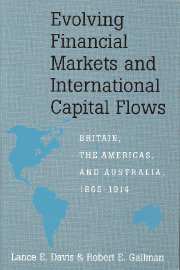 Evolving Financial Markets and International Capital Flows
Evolving Financial Markets and International Capital Flows Published online by Cambridge University Press: 18 August 2009
Introduction
The Australian experience stands in marked contrast to those of Canada and the United States. Although all three were frontier countries, initially Australia had by far the smallest population, and, therefore, population growth over the next half century depended relatively more on immigration. In 1865 the population of the six colonies was less than 1.4 million. In contrast, the Canadian population was 3.4 million, and that of the United States, 35.7 million. Over the next five decades Canadian population grew at an annual rate of 1.7 percent, that of the United States at 2.0 percent, but that of Australia at 2.5 percent.
Initially, Australian income had been raised by the gold and silver discoveries of the 1850s, but gold can be taken out of the ground only once. Between 1860 and the Western Australian discoveries of the late 1880s, precious metal production played a steadily decreasing role in the continent's economic expansion. Given the initial high levels of income and the subsequent exhaustion of the mines, except for the fifteen years from 1889 to 1904, Australia's economic performance was remarkably good. Between 1861 and 1889, when population was increasing by 3.5 percent a year, per capita real GDP rose by 1.3 percent per year; and between 1905 and 1914, when the rate of population increase was 2.3 percent, real per capita GDP was increasing by 2.9 percent (see Table 5:1-1).
To save this book to your Kindle, first ensure [email protected] is added to your Approved Personal Document E-mail List under your Personal Document Settings on the Manage Your Content and Devices page of your Amazon account. Then enter the ‘name’ part of your Kindle email address below. Find out more about saving to your Kindle.
Note you can select to save to either the @free.kindle.com or @kindle.com variations. ‘@free.kindle.com’ emails are free but can only be saved to your device when it is connected to wi-fi. ‘@kindle.com’ emails can be delivered even when you are not connected to wi-fi, but note that service fees apply.
Find out more about the Kindle Personal Document Service.
To save content items to your account, please confirm that you agree to abide by our usage policies. If this is the first time you use this feature, you will be asked to authorise Cambridge Core to connect with your account. Find out more about saving content to Dropbox.
To save content items to your account, please confirm that you agree to abide by our usage policies. If this is the first time you use this feature, you will be asked to authorise Cambridge Core to connect with your account. Find out more about saving content to Google Drive.